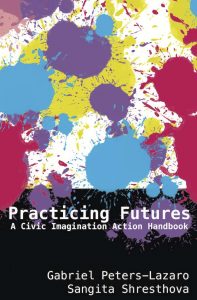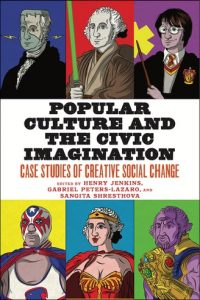For a more regularly updated listing of our publications please refer to the Civic Imagination Project site.
Key Books Published by the Project:
Practicing Futures
A Civic Imagination Action Handbook
Gabriel Peters-Lazaro and Sangita Shresthova
The real world is full of challenges and the sheer weight of problems facing us can stifle the genius of our collective human creativity at exactly the time when we desperately need imaginative and innovative solutions. Responding to this, Practicing Futures: A Civic Imagination Action Handbook harnesses our connections to popular culture and taps the boundless potential of human imagination to break free of assumptions that might otherwise trap us in repetitive cycles of alienation. Utopias and dystopias have long been used to pose questions, provoke discussions, and inspire next steps and are helpful because they encourage long view perspectives. Building on the work of the Civic Imagination Project at the University of Southern California, the Handbook is a practical guide for community leaders, educators, creative professionals, and change-makers who want to encourage creative, participatory, and playful approaches to thinking about the future. This book shares examples and models from the authors’ work in diverse communities. It also provides a step-by-step guide to their workshops with the objective of making their approach accessible to all interested practitioners. The tools are adaptable to a variety of local contexts and can serve multiple purposes from community and network building to idea generation and media campaign design by harnessing the expansive capacity for imagination within all of us.
Popular Culture and the Civic Imagination
Case Studies of Creative Social Change
One cannot change the world unless one can imagine what a better world might look like. Civic imagination is the capacity to conceptualize alternatives to current cultural, social, political, or economic conditions; it also requires the ability to see oneself as a civic agent capable of making change, as a participant in a larger democratic culture. Popular Culture and the Civic Imagination represents a call for greater clarity about what we’re fighting for—not just what we’re fighting against.
Across more than thirty examples from social movements around the world, this casebook proposes “civic imagination” as a framework that can help us identify, support, and practice new kinds of communal participation. As the contributors demonstrate, young people, in particular, are turning to popular culture—from Beyoncé to Bollywood, from Smokey Bear to Hamilton, from comic books to VR—for the vernacular through which they can express their discontent with current conditions.
A young activist uses YouTube to speak back against J. K. Rowling in the voice of Cho Chang in order to challenge the superficial representation of Asian Americans in children’s literature. Murals in Los Angeles are employed to construct a mythic imagination of Chicano identity. Twitter users have turned to #BlackGirlMagic to highlight the black radical imagination and construct new visions of female empowerment. In each instance, activists demonstrate what happens when the creative energies of fans are infused with deep political commitment, mobilizing new visions of what a better democracy might look like.
By Any Media Necessary
The New Youth Activism
There is a widespread perception that the foundations of American democracy are dysfunctional, public trust in core institutions is eroding, and little is likely to emerge from traditional politics that will shift those conditions. Youth are often seen as emblematic of this crisis—frequently represented as uninterested in political life, ill-informed about current-affairs, and unwilling to register and vote.
By Any Media Necessary offers a profoundly different picture of contemporary American youth. Young men and women are tapping into the potential of new forms of communication such as social media platforms, spreadable videos and memes, remixing the language of popular culture, and seeking to bring about political change—by any media necessary. In a series of case studies covering a diverse range of organizations, networks, and movements involving young people in the political process—from the Harry Potter Alliance which fights for human rights in the name of the popular fantasy franchise to immigration rights advocates using superheroes to dramatize their struggles—By Any Media Necessary examines the civic imagination at work. Before the world can change, people need the ability to imagine what alternatives might look like and identify paths by which change can be achieved. Exploring new forms of political activities and identities emerging from the practice of participatory culture, By Any Media Necessary reveals how these shifts in communication have unleashed a new political dynamism in American youth.




